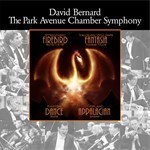|
Back
04/20/2014
Béla Bartók: Bartók Dance Suite
Ralph Vaughan Williams: Fantasia on a Theme by Thomas Tallis
Aaron Copland: Appalachian Spring Suite
Igor Stravinsky: Suite from “L’Oiseau de feu”
The Park Avenue Chamber Symphony, The Park Avenue Chamber Symphony Solo Quartet, David Edelson (Concertmaster/Violin 1), Robert Ruckman (Violin 2), Wendy Keyes (Viola), John Yakubik (Cello), David Bernard (Conductor)
Recording: All Saints Church, New York City (January 2008, October 2010, February 2014) & Skirball Center for the Arts, New York University (October 2007) – 80’
Park Avenue Chamber Symphony # PACSNAXOS0031 – Booklet in English

   
People attuned to listening to music from the late Romantic Era, with its complacent melodic structures and pleasant resolves, would move into music at the turn of the century with a bit of shock. Up against new musical formulations, the Age of Modernism paved way into musical panels bringing with it innovation, diversion and reaction.
David Bernard’s The Park Avenue Chamber Symphony (PACS) opens the window onto 20th century music featuring a CD that stretches all expectant boundaries. When asked about his selection, Maestro David Bernard is quoted as saying: “…this album was to give the listener a compelling sampling of Early 20th Century Music across differing styles of composition. But to make this compelling, I had to bring more than a variety of music from the same period. Each of these works from differing origins (Hungarian, English, American and Russian) is powerfully expressive—grabbing the listener and taking them on a journey that is as vivid and heartfelt as any work of art from this or any period.” Indeed, his points are well taken, for this musical portrait is sure to please those open-minded souls.
The Bartók Dance Suite will likely raise a few eyebrows. Conventional wisdom can be thrown out the door when attempting to define what ‘dance’ really means through the eyes of Béla Bartók. Broken into six movements, the “Moderato” stamps itself with a march-like initiating rhythm with its use of varying novel string techniques. Maestro Bernard musically parses through the “Allegro molto” that breaks the pacing with a dulcet harp glissando washing into another divisionary azimuth; the “Allegro vivace” screams with Hungarian-Slavic modernity that The PACS delves into with clairvoyance. Listeners are somewhat mollified in the ensuing “Molto tranquillo” with its opening ethereal, peaceful discourse, but it quickly raises questions of uncertainty and directional turning; it is mysterious, throbs with exotica and has transparent chording like a watercolor wash. By contrast, “Comodo” tugs and tussles, begging for some sort of discordant release. The “Finale-allegro” carries forward the earlier dialogue of turbulence. We return to a summary of the “Molto tranquillo” with the harp glissando, suddenly transitioning to the original theme, but riddled with variant clauses. Bernard’s brass is exceptional; the performance is unblemished.
Vaughan Williams’ Fantasia has The PACS’ violins holding a matchless tremolo high D while the lower strings pluck away. David Bernard captures the bounteous lines with English fervor. The music’s composition has a vein of dolefulness, struggling for normalcy. The pining solo violin (6:11) immediately transposes us to The Lark Ascending (1914) for brief moments of soulful delight. This is a particularly captivating piece, flowing with the ebbs and tides of the strings that is so indicative of Vaughan Williams. Saturated with a roughened pastoral sensuousness, David Bernard’s corps balances the piece with emotional tidings. The solo quartet adds exceptional value to an already highly evocative musical theme.
Appalachian Spring Suite is Copland’s musical testimonial of 1940s America that encapsulates differing heartbeats racing across field and plain at that time; one can’t help but feel this piece is distinctly indigenous to our country. Centering around the Shaker theme of “Simple Gifts”, Mr. Bernard’s orchestra plays with patriotic flavor, well positioned with honor and dignity. The lingering C major seventh chord is lovely.
The sneaky, foreboding notes stemming from the lower strings open Stravinsky’s Suite from “The Firebird”. Filled with dissonance, the piece soon releases into ethereal delight, conjuring influences by Claude Debussy. There is a certain sense of distance and ambiguity. The pursuant woodwind (flutes especially) section (3:16) has very similar chemistry to that found in Gabriel Pierné’s Cydalise et le chèvre-pied (1914) (read here). A sense of tranquility absorbs the score during the “Ronde des princesses.” Maestro Bernard enthralls the listener with tenacious dexterity through the “Danse infernale du roi Kastchei” (9:33-13:47) with its relentless unsettledness of meter change and key signatures. The vibrant parroting instrumental dialogue is razor-sharp and emphatically mesmerizing. Park Avenue’s sudden bursts of energy (11:45) bear resemblance to the swells found inside Chabrier’s España (1883). Inside the languid “Berceuse”, flickers of harp glissando and chording (15:23) register an attentive sense of Les Parfums de la nuit (1905-1908.) Maurice Ravel’s coloring immediately follows pursuit. PACS’ muted trembling of the strings is superb, seguing into the “Finale” with its fanfare for brass in majestic glory.
Sound on this recording is excellent. David Bernard’s personal write-up is technically precise and informative. The only issue of concern pertains to track listing: there are actually nine (9) tracks, yet the booklet only displays four (4) [it doesn’t break down the six (6) movements within the Bartók Dance Suite.] This adds a bit of confusion.
Nonetheless, David Bernard and The Park Avenue Chamber Symphony elucidate 20th century music in a cogent manner.
Christie Grimstad
|